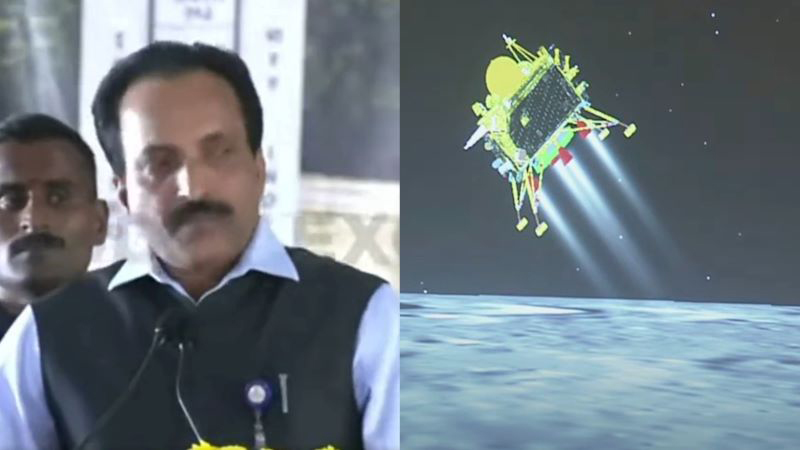 Chandrayaan-3
Chandrayaan-3
Not landing, ISRO chief says last 20 minutes was 'most difficult' part of Moon mission
New Delhi/IBNS: As Chandrayaan-3 successfully soft-landed on the South Polar region of the Moon on Wednesday-a feat matched only by Russia (then the Soviet Republic), the United States and China - guaranteeing India's place in the elite space club, Indian Space Research Organisation (ISRO) Chief S Somnath said the last 20 minutes was the most difficult phase of the lunar mission.
Chandrayaan-3's nearly 400,000 km journey to the Moon culminated in a nerve-wracking final 20 minutes, the 'power descent' phase, which is an automated landing sequence carried out by the lander, the ISRO chief said.
Shortly after the Chandrayaan-3 landed, a jubilant Somnath made a victorious shoutout saying: 'India is on the Moon'.
"The most difficult part of the mission is the launch itself... you should not forget that the GSLV Mark 3 (the rocket that launched the Chandrayaan-3 module that contains the Vikram lander and the Pragyan rover) did the job of putting the spacecraft into the right orbit."
"It went to 36,500 km and up to trans-lunar injection (which is a propulsive move used to set a spacecraft on a trajectory to the Moon) phase it went very well," Somnath said.
'Capturing the Moon' was crucial which refers to the critical moments when Chandrayaan-3 must identify a landing site, in which it is aided by high-powered cameras developed by ISRO - while it deboosts from lunar orbit and prepares for descent.
Miscalculations at this stage will be disastrous since it means the Vikram lander could crash as it attempts to touch down.
"Third critical moment is separation of the lander and orbiter, which happened at the appropriate time. Again, you must remember that this was after spending many days in space, in orbit, and the mechanism had to work without problems, which it did."
The Vikram lander, which contains the Pragyan rover, separated from the propulsion module on August 17.
The Chandrayaan-3 module separated from the rocket 16 minutes after launch and orbited the Earth six times, reaching a maximum distance of 36,500 km before the first orbit-raising move on July 15, taking it to a distance of 41,672 km.
"The second critical event is called 'landing and capturing on the Moon'. If you miss it then it (the possibility of landing on the lunar surface) is gone. You cannot retrieve it and there is no mission," the top scientist explained.
A smiling ISRO chief then said, "The last critical moment, of course, you watched along with us", referring to the tense moments leading up to Chandrayaan-3's Moon soft landing.
Lander Vikram's final touchdown speed was well within its safe limits. Four engines ran initially. Two of them were shut down later and therefore the touchdown on the lunar surface was powered by two engines.
The lander kicked up a large cloud of Moondust when it landed on the surface. The dust will not settle down anytime soon due to the extremely weak gravitational force the Moon exerts but will scatter away on its own momentum.
On landing, the first images of the Moon were captured on camera and shared by ISRO.
"The image captured by the Landing Imager Camera after the landing. It shows a portion of Chandrayaan-3's landing site. Seen also is a leg and its accompanying shadow. Chandrayaan-3 chose a relatively flat region on the lunar surface 🙂 #Chandrayaan_3 #Ch3," ISRO tweeted.
Chandrayaan-3 Mission:
— ISRO (@isro) August 23, 2023
The image captured by the
Landing Imager Camera
after the landing.
It shows a portion of Chandrayaan-3's landing site. Seen also is a leg and its accompanying shadow.
Chandrayaan-3 chose a relatively flat region on the lunar surface 🙂… pic.twitter.com/xi7RVz5UvW
The rover Pragyan has now emerged from the lander three-and-a-half hours after it touched down on the lunar surface near the Moon's South Pole. India is the first country to land a spacecraft near the lunar South Pole.
The Indian Space Research Organisation (ISRO) did not want the fine Moon dust to coat the cameras and other sensitive instruments, so it decided to wait for over three hours to ensure the dust moved away from the lander Vikram.
Support Our Journalism
We cannot do without you.. your contribution supports unbiased journalism
IBNS is not driven by any ism- not wokeism, not racism, not skewed secularism, not hyper right-wing or left liberal ideals, nor by any hardline religious beliefs or hyper nationalism. We want to serve you good old objective news, as they are. We do not judge or preach. We let people decide for themselves. We only try to present factual and well-sourced news.






